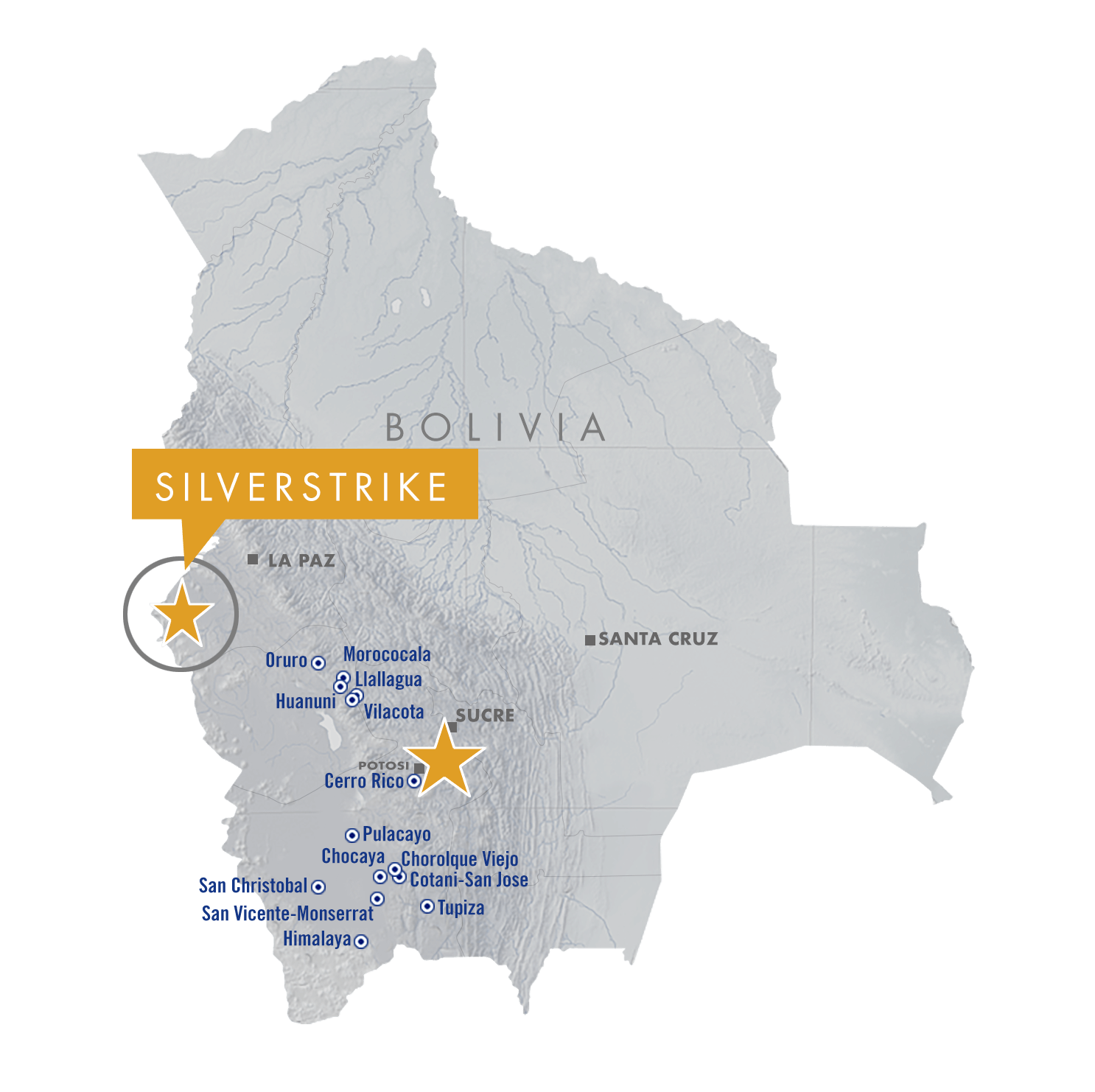Location
Silverstrike consists of 9 concessions totaling ~13km². The project is located approximately 140 kilometres (“km”) southwest of La Paz, Bolivia at an elevation of 4,000 to 4,500 m.

Geology and Mineralization
By using the geological knowledge gained at exploring the Silver Sand Project, the Company believes that the Silverstrike Project represents an opportunity similar to the Silver Sand Project with the potential to explore a large silver mineralization system.
Geologically, the Silverstrike Project is composed of Tertiary red sandstones and mudstone sequences (Mauri and Beren Formations) that were extruded by a Tertiary rhyolitic volcanic dome and associated pyroclastic sediments.
The Project contains extensive silver mining dumps (Figure-1) the results of Spanish Colonial mining activities which exploited near surface polymetallic silver-gold-lead-zinc (Ag-Au-Pb-Zn) mineralized bodies. Currently there are no active mining activities on site. The Silverstrike Project is divided into three areas according to the styles of mineralization:
1). Subvertical Ag-Pb-Zn mineralized fractures developed in sub-horizontal sandstones at Silverstrike North, where the mineralization seems to be related to bleached whitish sandstones by hydrothermal fluids. This style of silver mineralization is similar to that in Silver Sand Project;
2). Disseminated Ag-Au-Pb-Zn mineralization associated with rhyolitic volcanic dome or diatreme of 900m by 900m extent at the Silverstrike Central; and
3). Ag-Pb-Zn Mineralization in quartz and K-feldspar phenocryst rhyolite that intruded into red sandstone strata at Silverstrike South.
Rio Tinto extensively sampled the mining dumps in the Project area and drilled four diamond drill holes at Silverstrike North, and four diamond holes and twelve RC holes in Silverstrike Central in 1995. Near surface Ag-Au-Pb-Zn mineralization was identified in all three areas.

By access and locations, the Silverstrike North is divided into the Valley Zone, North Top, South Top, West Top, and the CP Zone.
Silver-containing sulfosalts and sulfides fill in open fractures in bleached sandstones in forms of sheeted veins, swarm veinlets, stockworks and crackle breccias at the Silverstrike North over an area of 3km by 3km. Dense fractures occur dominantly along the north-west-west to north-west directions at high angles that are generally confined within the red sandstone and only stringers or feeder zones cutting through the underlying red mudstones.
Rio Tinto has sampled extensively the mining dumps on surface (Photo 1) over an area 1.5km by 1.5km in 1995, yielding average grades of 150-200g/t silver and 1% lead (Figure 2). Rio Tinto also completed 1,000.6m of diamond drilling in four holes at Silverstrike North. The PFZ001 hole intercepted 2m @ 1,254 g/t Ag, 0.33% Pb, 0.19% Zn and 0.48% Cu from 88m to 90m, and the PFZ002 hole intercepted 2m @ 237 g/t Ag, 0.6% Pb, 0.07% Zn and 0.5% Cu from 120m to 122m.
Two holes drilled at the CP Zone did not intercept any meaningful mineralization.

Twenty-four grab samples taken by New Pacific from the mining dumps in the Valley Zone (including valley, slope and North Top) returned average grades 185g/t Ag, 0.93% Pb, 0.07% Zn and 0.21% Cu (Table 1)[1]. Fifteen grab samples from the mining dumps from the South Top and the CP zone averaged 193g/t Ag, 0.68% Pb, 0.08% Zn and 0.27% Cu. These results are consistent with the historical dump sampling results by Rio Tinto (Figure 2, Table 1). Future drilling by New Pacific will focus on the bleached sandstones from the South Top, North Top and the West Top.


Ubiquitous disseminated silver-gold-lead-zinc mineralization occurs in volcanic epiclastic sediments and breccias associated with rhyolite intrusives in a Tertiary volcanic diatreme system of 900m by 900m size. Historical mining sites and dumps are scattered around, but there are no active mining activities currently. In 1995, Rio Tinto completed four diamond coring holes totaling 1,267m with the best intercept 220m @ 45g/t Ag, 0.51% Pb and 0.44% Zn from 13.0m to 233.0m in hole BER-3 in the northern silver-lead-zinc mineralization area, and 12 reverse circulation holes totaling 2,986.7m with the best intercept of 62m @ 0.74g/t Au and 0.3% Pb from 112m to 174m in hole BRC-004 in the southern gold mineralization area.
Forty-nine grab samples from surface outcrops and dumps at Silverstrike Central returned average grades of 51g/t Ag, 0.16% Pb and 0.91% Zn (Figure 3, Table 1).

A 300m long East-West trending historical Colonial era adits and declines plus surface mining cuts along structures developed in the quartz-potassium feldspar phenocryst rhyolite body that intruded red sandstones with extensive mining dumps. Mineralization is hosted in sheared rhyolite along the contact structure of rhyolite intrusive with Tertiary red sandstones with the true width of mineralization unknown due to covering of mining dumps and talus. No modern exploration or current mining was recoded. Three samples from the mining dumps at the Silverstrike South returned average grades of 294g/t Ag, 3.3% Pb, 1.56% Zn (Table 1). Extensive post mineralization and active hydrothermal sinter and sinter sediments have also developed along the nearby river which may have made the geology more complex for the purpose of exploring Ag-Pb-Zn mineralization associated rhyolites.
Mineral Concessions and Ownership
In December 2019, the Company announced the acquisition of a 98% interest in the Silverstrike Project from an arm’s length private Bolivian corporation (the “Vendor”) by making a one-time cash payment of US$1,350,000. Under the agreement signed between the Company’s wholly-owned subsidiary and the Vendor, the Company will cover 100% of the future expenditures of exploration, mining, development and production activities. The agreement has a term of 30 years and renewable for another 15 years without any payment and is subject to an approval by Bolivia’s Jurisdictional Mining Administrative Authority (Autoridad Jurisdiccional Administrativa Minera or “AJAM”) .
The Silverstrike Project consists of nine ATEs with an area of approximately 13km² currently in the process of conversion to Mining Administrative Contracts before AJAM. The Vendor has also applied for exploration rights over areas surrounding the Silverstrike Project as part of the transaction.
